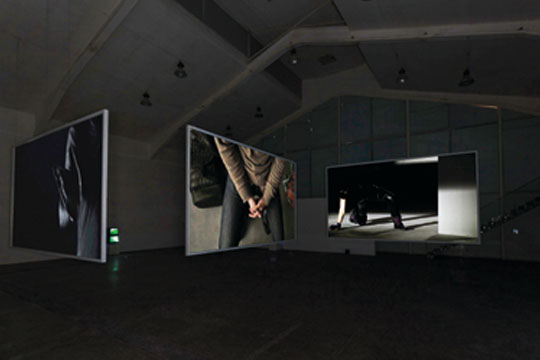ONCE
| March 31, 2014 | Post In 2014年2月号

Once, 2013
Three-channel HD video loop, 6 min. 5 sec.
For one artist to decide to create work in tandem with another always carries with it the risk of hit or miss. The meeting of uniquely subjective minds can be as dissonant and detrimental as it can harmonious and supplemental. Ideally, of course, the latter is achieved—two heads are better than one. In the case of the exhibition “Once,” the heads are three, and melody reigns.
This “one-off” project by Colin Chinnery, He An, and Zhang Hui was an attempt to merge the distinct practices of each artist within a territory commonly unfamiliar to all: video art. The result of this union was a three-channel video projected alternately on as many screens throughout Tang Contemporary’s vast main space. In one segment, a pony-tailed woman kickboxes in slow motion, bobbing determinedly but alone in a dim, empty industrial space, the lens fixed and unblinking in the face of her objectless violence. In the second segment, an array of still frames unfreeze one at a time, to show hands removing various objects from purses, bags, and backpacks. And in the third, two figures bound head to toe in cloth weave around one another in a giqong-inspired interpretive dance, their silver-lined silhouettes barely and only occasionally emerging from a plane of pitch black. This video is accompanied by the only sound in the gallery: an undulating chaos of skittering violins and electronic glitch that every once in a while, with a high-wattage zap, signals a clever interruption in the frame. This is seen as the face of one man, his eyes and mouth covered with paper cut-outs of other eyes and other mouths, appearing and disappearing under a piercingly bright flash: the acknowledgment and embrace of suprapersonal influence. Seen together, the three videos themselves sway as if in a slow, synchronized dance with one another, a resolute exploration of the realm of creative abandon.
Is the aesthetic nature of collective work inherently different from individual work? From the spectator’s point of view, yes, it is. Particularly for those familiar with the constituent artists’ individual practices, collaboration lends an artwork an air of mystery. (Given the weight of our own subjective experience, it is much easier to identify the machinations of independent creativity.) Who made which aspect of the work, and according to what sort of process? Here, the balance of intricacy and intrigue has been achieved—the viewer is offered multiple portals to depart her own cognizance and enter the space of a parallel universe, the poetic sum of a tripartite subconscious. Unfortunately, the artists could not leave it at that.
The second half of this exhibition consists of three smaller spaces—preluded by small television sets along the walls of the main space— containing independent creations rooted in elements extracted from the collaborative video. Dedicated interpretation of these individual works aside, there is an overwhelming sense that their presence alone is gratuitous. The video already possesses an impressive cohesion. Inevitably, then, we are left scratching our heads in bewilderment: why cram these three installations into the exhibition and disrupt that cohesion?
The official logic is that the artists’ collaboration was not the actual core of the show, but a “void” that “afforded them the potential of new discovery, not necessarily about group creativity, but something to feed back into their personal practice.” This logic is severely undermined, however, by the very nature of the individual artworks. In terms of form, medium, spatial arrangement, and so forth, each is as distinct as the artists’ own fingerprints. Indeed, they are so unmistakably typical of their practices that the purported “feedback” amounts to more than simple visual cues.
The ultimate mystery, then: whose decision was it to include the individual artworks? From this spectator’s perspective, the two possible answers are equally disheartening. The first is that the artists were not able to detach themselves from their egos. But this answer is negated by the very self-sustaining nature of the system they have together constructed via collaboration, a stability of which Chinnery, He, and Zhang must be aware; such can only emerge from great perspicacity. Thus, we may only suspect that another system has trumped their own, and deemed imperative the inclusion of the more marketable paintings and installations. Here, the melody of collaboration has been overshadowed by the accompaniment of its big brother: the din of commerce.

